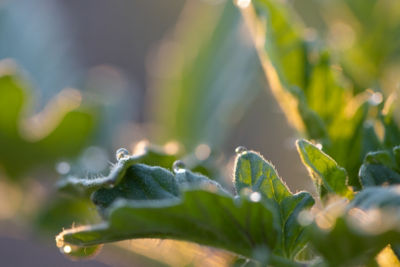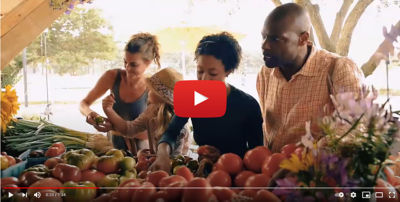Click here to download a PDF version of this spotlight.
» Seedless (triploid) watermelon seed requires specific conditions for adequate germination and emergence.
» Triploid watermelon seeds are almost always started in the greenhouse rather than direct-seeded.
» Triploid seedlings should be transplanted three to six weeks after planting.
Seedless watermelons are produced on triploid plants (three sets of chromosomes), which come from the cross of diploid (two sets) and tetraploid (four sets) plants. Triploid plants do not produce their own viable seeds, which is why the fruit are seedless. Because triploid seed is difficult to produce, it is more expensive than standard or hybrid diploid watermelon seed. Triploid seeds have thicker seed coats and are less vigorous than diploid seeds, so they usually have lower germination rates. Triploid watermelons are usually transplanted. 1,2 However, some growers have had success with direct seeding when soil conditions are favorable for rapid germination and growth.
Triploid seeds have special requirements for germination and emergence. Suboptimal conditions can result in reduced germination rates, uneven germination and seedling size, elongated transplants, and weak plants in the field. For these reasons, triploid watermelons are almost always started as transplants. Starting transplant seedlings in the greenhouse allows for better control of temperature and moisture conditions as well as seed placement. The added costs of transplant production are justified by the cost of the seed and increased production once in the field.1,4,5
 Figure 1. Automated filling of cell trays with planting mix
Figure 1. Automated filling of cell trays with planting mix
THE SEEDING PROCESS
The timing of seeding should be based on the desired transplant date. Transplanting should occur only after soil temperatures become favorable for rapid growth, the danger of frost has passed, and there has been sufficient time to prepare the planting bed.1 A typical recommendation is to transplant seedlings when they are four- to six-week-old. Some sources recommend transplanting three- to five-week-old seedlings, especially during the warmest planting times.1,5
Fungicide seed treatments are usually applied to triploid seed. These treatments help protect seeds and seedlings from infection by seedborne and soilborne diseases during the extended period from planting to emergence. Seed priming can also be used to help improve seed germination rates.
Seedlings can be produced in various-sized cell trays. Cell depths should be at least 1.5 inches, and a depth of 2 inches is recommended.1,4,5 Yields tend to increase with increasing cell volume, but cell volumes greater than 50 cm3 may not be practical. If trays with smaller cell sizes are used, more time will need to be spent monitoring plants and attending to their needs. Use square-shaped cells whenever possible, as round cells can result in root girdling.5
Fill the cells with a good planting medium formulated for transplant production (Figure 1). Coarse, light potting mixes that provide good aeration are usually best.2,4 Avoid using plug mixes because they are too fine and do not drain well.5 Premoisten the planting medium and let it drain for 8 to 24 hours before planting. Having the medium at the correct moisture when planting prevents the triploid seed from absorbing too much water and drowning.4
Triploid seeds tend to have low germination rates when temperatures are below 70°F. It is best to heat the planting medium to between 85° and 90°F prior to planting. In small-scale operations, filled cell trays can be covered with polyethylene sheeting and placed in the sun to warm the medium before planting.3,4 Plant one to two seeds per cell, and plant them ¾ to 1 inch deep. Older references recommend that seed should be planted with the radicle end pointing up (Figure 2). However, many growers no longer bother with this step, and automated (vacuum) seeding machines place the seed in random orientations. Cover the seed with moistened planting mix, vermiculite, or sand. A few growers plant seeds vertically with the radicle-end pointed down with the top of the seeds at soil-level. This helps the orientation of the radicle and eliminates the need for the plant to spend extra energy reorienting the radicle and pushing the seed coat out of the planting medium. Avoid watering the trays after seeding.1,4,5
Cover the trays with polyethylene sheeting and place them in a germination chamber/room. Keep seeded trays out of direct sunlight to avoid overheating.1 Germination rooms should be dark with temperatures between 85° and 90°F and relative humidity levels between 95 and 100%. Remove the trays from the germination room or chamber when seedlings first emerge or when radicles are visible in the drainage holes, usually 48 to 72 hours after planting. Watermelon seeds and seedlings need more oxygen than most crops, and triploid seeds are especially sensitive to overwatering. Therefore, keep the planting medium on the dry side. Use warm water if irrigation is needed. 1,2,3,4
 Figure 2. Planting seed with the radicle side pointing up may improve the rate of germination.
Figure 2. Planting seed with the radicle side pointing up may improve the rate of germination.
POST-EMERGENCE
When seedlings begin to emerge, transfer the cell trays to the greenhouse (Figure 3). Hold temperatures between 80° and 85°F until emergence is complete. After emergence, set the greenhouse daytime temperatures to between 70° and 80°F and nighttime temperatures between 65° and 70°.1,4 For the first seven to ten days, water the trays just enough to keep them moist but not wet, irrigating with warm water. Once seedlings are established, increase the amount of irrigation to adequately supply the needs of the seedlings. Thin to one plant per cell. Start fertilizer applications after the first true leaf is fully expanded. Apply nitrogen at 50 ppm using continuous feed or 100 ppm twice per month.5 Reduce fertilizer applications several days before transplanting.
Seedlings are ready to transplant when their root systems are developed to the point where the roots hold the planting mix together in a stable root ball and seedlings are easy to remove from the cells, three to six weeks after planting. At this stage, seedlings will have two to three true leaves. Transplanting older seedlings often causes transplant shock, resulting in delayed growth and lower yield potential.1,2,5
 Figure 3. Emerged watermelon seedlings in deep, square cells.
Figure 3. Emerged watermelon seedlings in deep, square cells.
SOURCES
1 Maynard, D. N. 1997. Triploid watermelon transplant production. 8th International Symposium on Timing of Field Production in Vegetable Crops, Bari, Italy. Acta Hortic. 533, 109-112.
2 Hodges, L. 2007. Growing seedless (triploid) watermelons. NebGuide. G1755. University of Nebraska.
3 Goldy, R. 2012. Seedless watermelon – how do they do that? Michigan State University Extension. https://www.canr.msu.edu/news/seedless_watermelon_how_do_they_do_that.
4 Maloney, B. 2001. Keys to success for germination of triploid watermelon seeds. Vegetable Production & Marketing News. Texas A&M University, Extension Horticulture.
5 Hassell, R. and Schultheis J. Seedless watermelon transplant production guidelines. https://www.clemson.edu/cafls/research/coastal/research/watermelon.html.
Websites verified 3/15/2022
ADDITIONAL INFORMATION
For additional agronomic information, please contact your local seed representative.
Performance may vary from location to location and from year to year, as local growing, soil and weather conditions may vary. Growers should evaluate data from multiple locations and years whenever possible and should consider the impacts of these conditions on the grower’s fields. The recommendations in this article are based upon information obtained from the cited sources and should be used as a quick reference for information about watermelon production. The content of this article should not be substituted for the professional opinion of a producer, grower, agronomist, pathologist and similar professional dealing with this specific crop.
BAYER GROUP DOES NOT WARRANT THE ACCURACY OF ANY INFORMATION OR TECHNICAL ADVICE PROVIDED HEREIN AND DISCLAIMS ALL LIABILITY FOR ANY CLAIM INVOLVING SUCH INFORMATION OR ADVICE. 7016_20900
Published 04-19-2022
Bayer, Bayer Cross Design, and Seminis® are registered trademarks of Bayer Group. All other trademarks are property of their respective owners. © 2022 Bayer Group. All rights reserved.




